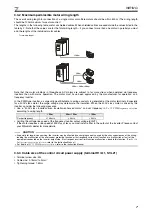
8
WIRING
3.4 Control circuit specification
3.4.1 Standard control circuit terminal layout
3.4.2 Wiring instruction
Terminals PC, 5, and SE are all common terminals (0V) for I/O signals and are isolated from each other. Avoid
connecting the terminal PC and 5 and the terminal SE and 5 (ground). Terminal PC is a common terminal for the contact
input terminals (STF, STR, STOP, RH, RM, RL, JOG, RT, MRS, RES, AU, CS).
Use shielded or twisted cables for connection to the control circuit terminals and run them away from the main and
power circuits (including the 230V relay sequence circuit).
Use two or more parallel micro-signal contacts or twin
contacts to prevent a contact faults when using contact
inputs since the control circuit input signals are micro-
currents.
Do not apply a voltage to the contact input terminals (e.g. STF) of the control circuit.
Always apply a voltage to the alarm output terminals (A, B, C) via a relay coil, lamp, etc.
It is recommended to use the cables of 0.3mm² to 0.75mm² gauge for connection to the control circuit terminals.
If the cable gauge used is 1.25mm² or more, the front cover may be lifted when there are many cables running or the
cables are run improperly, resulting in a fall off of the operation.
The wiring length should be 30m maximum.
The level of the control signals can be switched over between positive (SOURCE) and negative (SINK) logic. The input
signals are set to source logic when shipped from the factory. To change the control logic, the jumper connector on the
back of the control circuit terminal block must be moved to the other position.
Terminal screw size: M3.5
Tightening torque: 1.2Nm
Micro signal contacts
Twin contacts















































